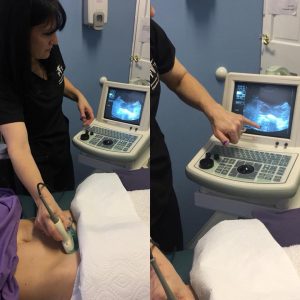Here we are using Rehabilitative Real-Time Ultrasound to help our patient downtrain the dominant use of her transversus abdominus muscle (a lower abdominal muscle). Many people who perform Pilates learn to overuse their lower abdominals instead of utilizing their pelvic floor muscles. The overuse of abdominal muscles during a pelvic floor contraction can create a downward force on the bladder. This is counterproductive because the pelvic floor contraction is to gain support of the bladder in an elevation pattern. The pelvic floor needs to contract in an “elevator fashion” upwards or cranially or towards the head. The pelvic floor muscles have 3 layers and each layer should contract upwards sequentially. This is important to understand when pelvic organ prolapse and bladder leaking or incontinence is an issue in the post-partum patient. Patients can view their muscle function, related to lumbar, pelvic, and bladder functioning, using rehabilitative ultrasound. Patients can better understand their abilities while viewing the actual anatomy being tested and assessed. A patient can view their bladder and how a pelvic floor contraction effects its position. This is ideal biofeedback for the patient.




